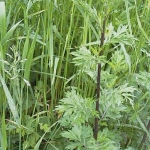
Named for the Greek goddess Artemis, Artemisia is a genus containing about 300 species, although few are grown in gardens. A number of species inhibit other plants, sometimes to the point of death.
Mugwort is a perennial that spreads via rhisozes. It grows to about 3ft (90cm), with deeply incised leaves that are deep green above and grayish white below.
Aromatic, perennial with red-purple stems and deeply cut, dark green leaves, 5-8cm (2-3in) long, with white undersides. Panicles of tiny red-brown flowers appear in summer.
Propagate all perennial artemisias by semi-hardwood cuttings taken from midsummer to autumn, or raise from seed. Propagate rhizomatous species by root division in autumn. Directly sow the annual species A. annua into the garden in spring, or raise as seedlings and transplant at 6 weeks. |
|
Harvest the leaves as required to use fresh or dried. |
|
Has yellow-variegated foliage Variegated |
|
By the sixteenth and seventeenth centuries, much of the medieval madness around mugwort’s magical uses had dissipated and the British herbalist John Gerard and Nicholas Culpeper wrote extensively about the herb’s effectiveness in treating anxiety, indigestion, and poor appetite. |
|
Mugwort is used as a digestive stimulant and nerve tonic, and is also used to treat menstrual problems. Mugwort has antidepressant, appetite-stimulating, calming, digestive, diuretic, sweat-promoting, and tonic properties. It also stimulates the uterus and expels intestinal worms. Mugwort is taken internally for depression, bladder ailments, cramping pain, heavy and scanty menstrual bleeding, indigestion, intestinal worms, menstrual irregularities, poor appetite, stress, and uterine bleeding. Extracts of the fresh leaves are sometimes used externally to treat fungal infections and warts. Mugwort powder may be added to a warm bath to ease rheumatic pain and stiffness. |
|
The Complete Illustrated Book of Herbs by Reader’s Digest Copyright©2009 The Reader’s Digest Association, Inc. Pg 17 The Modern Herbal Primer by Nancy Burke Copyright©2000 Yankee Publishing, Inc. pp. 82-83 |


